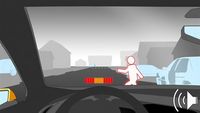Safety 2008-2009 - Overview Of The Safety Work Within Volvo Cars
GOTHENBURG, Sweden – January 21, 2009: Volvo Cars builds many of the safest cars on the market. Ever since Volvo Cars was founded, safety has been a cornerstone of the company philosophy. The aim is to offer cars that are safe for all people in all imaginable traffic situations. The key to success in this respect is to design safety systems that are smart and that interact with one another. Volvo Cars bases its research on a variety of parameters, including data obtained from actual road accidents, with the future aim of ensuring there are no fatalities or serious injuries in or owing to a Volvo car.
XC60 -Volvo's safest car ever
2008 saw the launch of the new
XC60 on the market. This model has a safety level of absolute world class
and its standard specification includes City Safety, a function that helps
the driver brake if he or she is about to drive into the car in front. City
Safety has been developed to reduce the risk and consequences of a rear-end
collision, something that is very common in urban traffic and when driving
in slow-moving tailbacks. The system is active at speeds below 30 km/h and
is estimated to be able to reduce the occurrence of this type of accident
by 50%.
Vision 2020
2008 was also the year when Volvo Cars clearly
expressed its safety vision for the future - to design cars that should not
crash. In the shorter perspective the aim is that by 2020 no-one should be
killed or injured in a new Volvo car. The road there is challenging and
part of the solution will be technology that involves cars and
infrastructure communicating with one another.
WHIPS turns 10
Whiplash injuries are among the most common
traffic injuries. It was back in 1998 that Volvo Cars introduced WHIPS, an
effective system that protects the neck in a rear-end collision. The
system, which halves the risk of long-term injuries, has now been around
for ten years. WHIPS is fitted as standard in the front seats of all Volvo
car models.
Technology for sober driving
Along with failure to use safety
belts and excessive speed, drink-driving is one of the biggest
traffic-safety problems. Since the start of 2008, Volvo has offered an
alcolock with the aim of preventing drivers from driving under the
influence of alcohol. The alcolock is based on advanced fuel-cell
technology and is very reliable.
Avoiding accidents
One effective way of reducing the number
of injuries and fatalities in traffic is to help the driver avoid an
accident in the first place. Surveys reveal that up to 90% of all accidents
are caused by the driver being distracted and failing to concentrate fully
on the road. This is therefore an area of top priority at Volvo Cars. For
example, Volvo offers Driver Alert Control, which monitors attentiveness
and alerts the driver if he or she shows signs of distraction or erratic
driving. Collision warning and auto-braking are also offered on several
models.
If an accident occurs
If an accident is unavoidable, Volvo's
cars have been developed to help protect their occupants. Many different
safety systems interact to provide effective protection: airbags, advanced
grades of steel with energy-absorbing abilities, and safety belts with both
belt pre-tensioners and force limiters.
Unprotected road-users in focus
Every year, thousands of
pedestrians are injured and killed on roads and Volvo is working to reduce
this figure. At the end of 2008, a unique new technology was unveiled that
allows the car to detect pedestrians in the collision risk zone, alerting
the driver in advance. If the driver does not respond to the warning, the
car brakes itself and at low speeds the accident can even be entirely
avoided. And if a pedestrian is hit, the front of the Volvo is designed to
absorb the impact energy and reduce the severity of personal injuries.
Safe for the smallest passengers
Volvo Cars offers a wide
range of child-safety equipment for children of all ages. A young child's
head is large and heavy in relation to the rest of its body and the child's
weak neck cannot adequately support the head in a collision. That is why
Volvo Cars strongly recommends that children should ride facing the rear
for as long as possible, at least until the age of 3 or 4. For older
children, from 4 to about 10 (140 cm) there are booster cushions. These
help position the belt correctly across the shoulder and thighs and prevent
the belt from sliding up across the more vulnerable abdomen. In order to
boost the use of child-safety equipment, there are also integrated booster
cushions in Volvo's cars. They can be adjusted to two heights, making them
useful over a long period of time as the child grows. Pregnant women should
always use the safety belt, even during the final stages of pregnancy. The
airbag should also remain activated.
Safe and sound with personal security
At the mere touch of a
button in the Volvo Personal Car Communicator (PCC) you can determine
whether the car is locked or not, wherever in the world you happen to be.
It is also possible to see if anyone is inside the car and whether the
alarm has been activated.
Crash-test laboratory
The heart of Volvo Cars' Safety Centre
is the crash-test laboratory. It opened in 2000 and is one of the most
advanced in the world. Here it is possible to recreate real-life accident
scenarios and the researchers test the various car models in various
collision situations.



